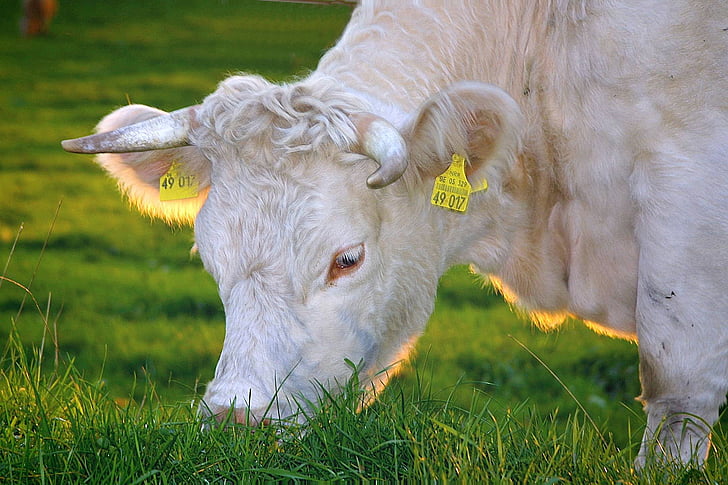5 tips for mastering grass-finished cattle
The grass-fed meat segment (including beef, sheep, pork and poultry) and especially the organic meat segment are still small within the meat industry. However, its dollar growth is increasing fast, certainly more than the total meat category. Grass-fed beef in particular presents a lucrative opportunity for producers, who can realise major price premiums for grass-fed, pasture-raised, or local meat. In the United States for instance, grass-fed beef can sell for $2.50 to $3 retail price) more per pound (0,45 kilos) than conventionally produced beef according to Consumer Reports. But finishing grass-fed livestock takes time, effort and patience, and the return on investment is not always immediate.
Hustler field consultants have accumulated tips from farmers and ranchers around the world that we have summarised in this article.

1. START WITH THE OBVIOUS
Often forgotten because it requires time and easily accessible cattle-yard, visual inspection is one of the simplest ways to monitor an animal’s progress toward finishing. Depending on the period of the year you choose to finish your cattle, a long hair coat can disguise the cattle’s true shape. Key areas to assess whether sufficient fat has been laid down are more likely to be the ribs, transverse processes, tail head and rump. Most of the cattle breeds lay down fat from head to tail, so the tail head is a good indicator. A lot of farmers and ranchers say that as a rule of thumbs if the tail head feels more like the back of your knuckles when you make a fist, the animal is probably not ready yet. If you have access to a scale, recording weights every couple of weeks at the same time of the day during the finishing period can be an excellent way to know whether your grazing program is leading to gains in order to adjust it if necessary.
2. MANAGE YOUR PASTURES CAREFULLY THROUGHOUT THE YEAR
Yes, not all regions in the world are equal. Soil or climate has an impact on the grass growth rate. But manage carefully, your pastures can reward your efforts and your bottom-line. It also means that you can rely more on your own land, as well as for grazing as making hay. Our customers all over the world are unanimous: gaining feed autonomy is often the key to long-term and sustainable success. For further information, read our previous articles about rotational grazing and pasture management, about how bale feeding can help to improve your pastures for (virtually) free and watch the story of the Millers’ dairy farm in Louisiana.
3. CHOOSE YOUR HAY/BALEAGE CAREFULLY
As we mentioned earlier, because all regions in the world are not equal and the grass growth rate can change from one year to another, you may need to use more or less hay/baleage to support your cattle intakes. The adage ‘you are what you eat’ holds true for cattle as well. The type of forage an animal consumes before butcher can affect the flavour as well as marbling. If you can, you would ideally finish your cattle on a combination of pasture grazing and high-quality hay/baleage that you kept for this purpose. Feeding your animals for finishing is not always only about quantity, but also quality. It would help your herd to reach finishing weights even faster. Make also sure that you feed out the correct quantity, enough for your cattle to gain but not too much to avoid wastage that would impact substantially your total expenses. We can help with reducing wastage, check out our article about how to reduce wastage by limiting access to feed.
4. SELECT GENETICS THAT DO BEST ON GRASS
As it is true for lands, not all animals are equal, even among a breed. Select fast-growing, moderately sized cattle that are deep-bodied with ample milk production for optimal grass-fed beef production. Larger framed animals have higher forage intake requirements and may have more trouble keeping conditions during the stress of summer and winter. They will also likely take longer to finish. A deep-bodied animal suggests a large rumen capacity, which means it can fill up on plenty of forage during each grazing session. Early maturing breeds will begin to lay down fat more quickly allowing you to make the most out of its first grazing season after birth, while breeds known for ample milk supply will keep calves full without needing to supplement their diets to support lactation. You can also try crossbreeding to achieve the perfect mix according to your own situation.
5. EDUCATE YOUR CUSTOMERS
This last tip is maybe less about your cattle than your customers. There are several different marketing channels for grass-fed beef, including selling finished animals to a packer or direct marketing grass-fed beef to local consumers, chefs, and co-op grocery stores. But if consumers know what they want, they not always know what it implies for the producer. As a result – each to their own trade after all – you may need to educate patiently your customers. Teach them – with flyers, with a website, even with organising farm tours – that finishing animals on grass is a lengthier process than grain-finishing, often requiring between 24 and 30 months. If you get a lot of enquiries, good for you, but don’t send to slaughter the first steer who runs by. Educate your customer is also prioritising over meeting demand. Create a waiting list and send seasonal updates to get your customers used to the idea what a high-quality product really means.


























